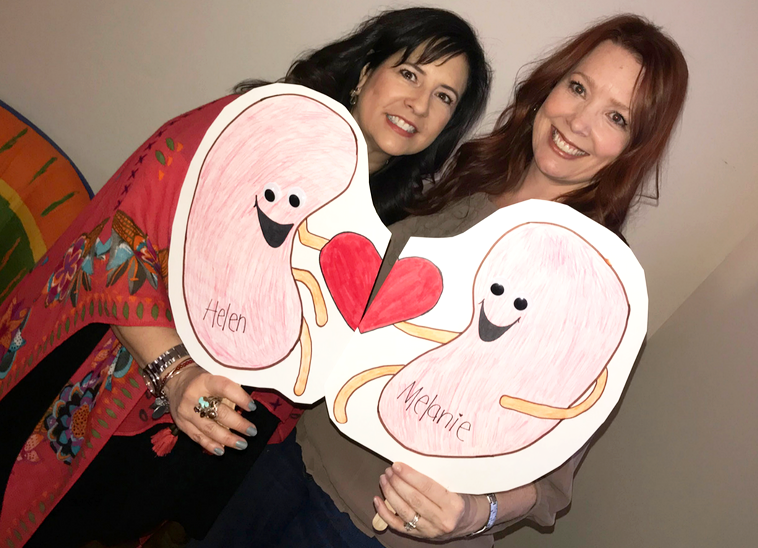
“Nobody can do everything, but everyone can do something.” -Author Unknown
Growing up, Helen Nielsen always knew there was a possibility that she would have polycystic kidney disease.
Polycystic kidney disease (PKD) is a genetic disorder in which cysts grow within the kidneys, causing the kidneys to enlarge and lose function over time. A child with a parent who carries this disease has a 50% chance of getting PKD. “I’ve lived with this my whole life,” shares Helen, director of human resources at Lovelace Medical Center, Heart Hospital of New Mexico at Lovelace Medical Center and Lovelace UNM Rehabilitation Hospital. “My mother had it, my aunt had it and I have cousins who have it. It’s pretty prevalent on my mother’s side of the family,” she says.
At thirty years old, Helen’s diagnosis was confirmed. “My aunt found out she had it so I thought it would be a good idea to get tested. Sure enough, they saw a couple of cysts. They told me at that point that my kidneys were still functioning fairly well.”
Fast forward twenty years; Helen’s condition has advanced.
“The ultimate result of the disease is that you will have kidney failure at some point. Every year, my kidneys begin to deteriorate. I’ve seen that maybe in the last ten years,” shares Helen. “Year after year I’ll go to the doctor and he will tell me that my levels are declining but I’m still functioning. About a year and a half ago, I entered what’s called Stage 4. And at that point, when you see Stage 4, it’s time to start thinking about your options. You either go on dialysis to stay alive or get a kidney transplant.”
Currently there is no cure for PKD. In addition to a possible transplant, individuals with PKD are encouraged to practice good kidney health to control symptoms and slow down the loss of kidney function.
“Having a healthy lifestyle will contribute to a healthy kidney. Unfortunately, the disease will progress with or without you. But you do want to keep your heart and mind healthy because if you do get to the point where you are able to receive a donated kidney, then you have to be able to withstand that surgery. If I had diabetes or heart failure, it would be less likely that I would be able to receive a new kidney. With that in the back of my mind I’ve always been trying to monitor my lifestyle by trying to monitor my blood pressure, weight and by not smoking,” says Helen.
Despite battling internal kidney issues throughout her life, Helen never felt the effects of this disease.
“I’ve never really felt bad, and I still feel pretty darn good, aside from a cyst dislodge here and there. You start thinking, ‘Wow I can’t believe I’m entering this phase of my disease.’ I was very blessed because I knew how it will progress because I had family members who went through it. Through their experience and my own, I understand the disease and what to expect. When they told me I was going in Stage 4, I knew I needed to try to do what I could to get a transplant. Therefore, I got on the list right away. The process was to work with a participating hospital that does kidney transplants. I had to go to each facility and get on their list. I started off at the Mayo Clinic and then I got on the University of New Mexico Hospital’s list. Once I started telling family and friends that I had this disease, I did get some friends who came forward to get tested to find a match.”
Melanie Wagner, director of materials management at Lovelace Medical Center, was one of those friends. Their friendship began in 2010 when they were both working at Lovelace Westside Hospital. Helen shares, “We became fast friends and now we’re friends outside of work too. We have a special friendship.”
Melanie said, “When Helen said that she needed a transplant, I didn’t even hesitate to get on that list. I started the whole process in September. We finally got the news at the end of January. When you go through all of the testing, there are two different committees: you have your recipient committee and your donor committee. My donor committee met and that includes a dietitian, physician surgeon, and my specific coordinator. The team went over all of my tests and paperwork and approved me to move forward in the process.”
Helen says, “Melanie, bless her, was one of the people to come forward. I’ve had two other donors go through the testing process. One wasn’t a match at all, and the other was a match, but unfortunately her health screening did not come back positively to where she was given the approval to give a kidney.”
Between September 2017 and January 2018, both Nielsen and Wagner went through ongoing tests and examinations. Testing is designed to ensure that not only the recipient is healthy enough to receive a new kidney, but that the donor is healthy enough to give a kidney. Helen adds, “Part of the drawback of being a donor is you have to go through rigorous testing to see if you’re healthy enough to give a kidney.”
Melanie shares, “There was a lot of testing between September and January. They took 15 vials of blood to test different organs, they checked for cancers and diabetes. I had a CT scan, ultrasound, MRI, mammogram, pap smear and more.” Melanie laughs, “On the plus side, you find out if you have any issues!”
Hearing the news that she would be able to donate her own kidney to her friend caused an outpour of relief and happiness, according to Melanie.
“It was very exciting and very emotional. My coordinator called me one day and told me that the committee was finally going to move me forward,” she says.
Melanie admits that the past few months have not been easy. “It’s been an emotional rollercoaster for sure. It was a frustrating process. Here I am watching my friend’s health deteriorate and I just felt the hospital didn’t have a sense of urgency. At the same time, I understood why they were taking the precautions that they were.”
Helen adds, “You’re very humbled that someone would even do this for you. It is amazing. Melanie has two young boys and a wonderful husband that is supportive. That is always on my mind. It’s still a surgery and it’s still a risk. It’s overwhelming to know that somebody is that unselfish and such a giving soul.”
Helen will receive her new kidney on May 9, 2018 at the University of New Mexico Hospital.
Helen says, “In the back of my mind, I always thought it was going to be at Mayo Clinic, and both my donor and I would be there for 6 weeks. That would’ve been rough. Melanie laughs, “Luckily we’ll be here so we can go to work the next week!”
Joking aside, the recovery time for kidney transplants is about six to eight weeks. “The first one hundred days after surgery is the critical, because you become immune-suppressed. The rest of your life you will be immune-suppressed. They will force my immunity system to drop because this is a foreign thing coming into my body, so the doctors don’t want my body to fight it. When you’re immune-suppressed, you’re susceptible to other challenges like infection and disease so you have to be really careful,” says Helen.
The light at the end of the tunnel is what has guided Helen through her condition.
“Of course I am looking for this to not hang over my head anymore,” Helen said. “I’ll be able to proceed like a normal human being. It’s a gift and I will always take care of that kidney. I will strive to live healthy and take care of myself so that I don’t have to down this path again. That’s the commitment I’m making to myself. People don’t realize that they can do this. People don’t realize that they can donate. For people to understand that’s an option is important.”
Over 3,000 new patients are added to the kidney waiting list each month, according to the National Kidney Foundation. To officially register as a donor, visit https://www.donatelife.net/




